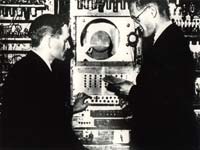|
In 1948 an innovative memory device, a storage system now
known as the Williams-Kilburn Tube, allowed the first electronic digital
stored-program computer to be built in Manchester.
To understand the development of the information age,
historians also need a storage system.
Computing machines became central to technological and social change
in the twentieth century; their use determines many aspects of our lives
in the twenty-first. British institutions and individuals played an
important role in this process. However, the records and artefacts which
might help the historian to document it are fast disappearing.
The UK National Archive for the History of Computing (NAHC) was
created in 1987 as a repository for the documents and images of computer
history, and a centre to encourage its study. A rich collection is now
available to scholars.
|

Tom Kilburn (left) and F C Williams at the console of the Manchester
Mark 1 computer, 1949. This machine grew from the 'Manchester Baby',
which in 1948 first demonstrated the now-standard technique of
storing both data and programming instructions digitally. |